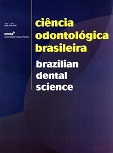Avaliação da dureza Vickers de resinas compostas de uso direto e indireto
DOI:
https://doi.org/10.14295/bds.2009.v12i1.249Abstract
Objetivo: Este estudo propôs avaliar a microdureza de diferentes resinas compostas de uso direto (rcd) e indireto (rci).Materiais e Métodos: Com o auxílio de uma matriz metálica (diâmetro: 5,0mm; espessura: 2,0mm) foram confeccionadas 70 amostras, sendo (n=10) três resinas de uso direto: Gr1- Z250(3M ESPE/EUA), Gr2- W3D(Wilcos/Brasil) e Gr3- Esthetic X(Dentisply/EUA); e quatro de uso indireto: Gr4- Resilab Master (Wilcos/Brasil), Gr5- Vita VM LC (Vita Zahnfabrik/Alemanha), Gr6- Vita Zeta (Vita Zahnfabrik/Alemanha) e Gr7- Sinfony (3M ESPE/EUA). As amostras das rcd foram confeccionadas utilizando a técnica incremental, onde cada incremento de resina foi fotopolimerizado durante 40 segundos. Já as amostras da rci foram polimerizadas segundo recomendações dos fabricantes. Todos os espécimes foram armazenados em água destilada a 37ºC durante 24 horas. O teste de microdureza foi realizado em microdurômetro digital (Future-Tech, Modelo FM 700), com carga de 50 kgf por 15 segundos. Os dados obtidos (Kgf/mm2) foram analisados utilizando o teste não paramétrico de Kruskal-Wallis e o de comparação múltipla de Dunn (p<0.05). Resultados: As medidas resumo-numéricas de microdureza obtidas foram (mediana; média ± desvio padrão): Gr1 (100,12; 101,07± 5,99 Kgf/mm2), Gr2 (83,55; 84,20±5,07 Kgf/mm2), Gr3 (73,98; 73,95± 6,55 Kgf/mm2), Gr4 (52,50; 52,54± 5,9 Kgf/mm2), Gr5 (33,25; 34,36± 2,29 Kgf/mm2), Gr6 (29,60; 29.68± 1.52 Kgf/mm2), Gr7 (25,39; 25.13± 2.08 Kgf/mm2). Verificou-se que os valores de microdureza das rcd analisadas não diferiram estatisticamente entre si (p<0,05). O mesmo não se pode estabelecer para as resinas indiretas, pois a Sinfony diferiu da Resilab (p<0,05). Conclusão: Baseado nos resultados pôde-se concluir que apenas a resina composta direta Z250 apresentou valores de microdureza Vickers superior às demais resinas indiretasDownloads
Downloads
Published
How to Cite
Issue
Section
License
Brazilian Dental Science uses the Creative Commons (CC-BY 4.0) license, thus preserving the integrity of articles in an open access environment. The journal allows the author to retain publishing rights without restrictions.
=================




























